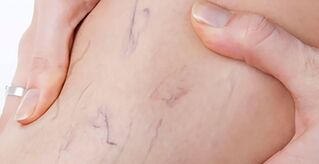
Small protruding veins are not yet intimidating, but should make you think!
The initial stages of the disease are characterized by mild symptoms. However, a woman who cares about her health should not lose sight of the first signs of the development of varicose veins:
- feeling of heaviness in the legs at the end of the day;
- swelling of the feet;
- the appearance of pigmentation on the skin of the lower legs and thinning of the skin;
- Numbness of the limbs, frequent leg muscle cramps;
- protrusion of the veins above the skin surface;
- the appearance of a pattern of veins, spider veins on the legs.
When a woman returns home after a day at work and her legs are in a “unfortunate state”, one should not just blame uncomfortable shoes or an extra “piece of salty food” over dinner. Swelling and heaviness in the legs are the first signals of the development of blood stagnation in the vessels. Remember - venous disorders are difficult to treat. Early prevention and timely medical treatment can stop or significantly slow down the process of vein dilation. Treatment should be started as early as possible.
Grade 1 varicose veins
The main causes of varicose veins are pregnancy, weight gain, prolonged physical activity, a sedentary lifestyle, and a genetic predisposition to such a disease. The common people called varicose veins "the flight attendant's disease" because of the peculiarities of this occupation and longstanding. This degree of disease is the mildest.
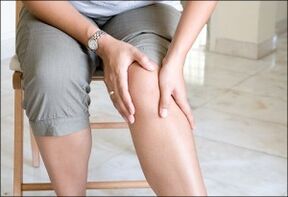
Classify the disease according to various factors. One of the classifications relates to the developmental stages of the disease:
- Varicose veins 1st degree or compensation level.
- Varicose veins 2nd degree or level of subcompensation.
- Grade 3 varicose veins or stage of deconpensation.
Different stages of varicose veins of the lower extremities are treated radically differently. You shouldn't try to cope with the disease on your own. This can only do harm and lead to disastrous consequences. It is better to contact a competent specialist.
The first degree of varicose veins is characterized by night swellings and night cramps. Often times, people mistake all of these symptoms for ordinary fatigue. Even at this stage, however, preventive measures need to be taken, including warming up your feet to improve general blood circulation, light foot massage, regular swimming and cycling.
Varicose veins of the first stage can also manifest as cramps in the calf area. Patients often complain of a stretching sensation in the legs or a burning sensation in the muscles. Increasingly, this is accompanied by pain in the lower extremities.
Already at this stage, manifestations of the visual character of varicose veins can be recognized, which should immediately alarm:
- Slight cyanosis of the skin.
- The first spider veins appear on different parts of the body, more often on the legs.
- Visible tortuosity of the veins.
First-degree varicose veins are most often manifested in such external changes.
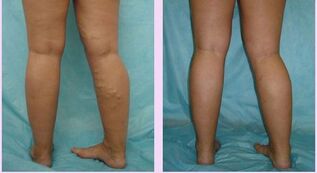
Another important factor in the manifestation of the first stage of varicose veins is the external conditions in which a person is. For example, in a hot environment, symptoms increase, swelling, pain and cramping increase.
Treatment of first degree varicose veins
Sometimes doctors recommend adding venotonics, which are very effective in treating varicose veins in the first stage. Regardless of this, it should be said about massage: not every such therapy is suitable for this disease. If after the procedure the pain only intensifies, it is necessary to change the approach to choosing a massage complex.
It is worth arranging relaxing, cool baths for the feet more often, which will soothe muscles, relieve swelling, relieve pain and remove fatigue. However, hot baths should be excluded, as they will not improve the condition of the limbs with varicose veins.
Doctors can recommend the following treatments for these types of varicose veins:
- Sclerotherapy - A special medicine is injected directly into a vein with a needle. The action of the drug is aimed at the resorption of veins, strengthens weak vascular walls and blocks blood flow in the desired area.
- Ozone therapy - a measure to strengthen the blood vessels and to resorb spasmodic stars.
Any of the above options are very effective. However, the maximum effect can only be achieved if all the recommendations that must be followed after applying the procedures are followed.
The wearing of special compression clothing is of the utmost importance. Such an element helps create pressure in the veins, which prevents them from expanding further.
Causes of the disease
There are more than fifty reasons that can trigger a change in the venous system. Particularly susceptible to the disease are people whose job involves leg strain and sedentary work: salespeople, hairdressers, programmers, accountants, drivers.
Scientists have researched for many years and identified the main factors that cause varicose veins:
- Hormonal changes in the body: pregnancy, menopause, youth;
- obesity of any degree;
- Genetic predisposition. 70% of children whose parents suffered from venous insufficiency develop varicose veins;
- Weak muscles;
- Wearing uncomfortable underwear: socks with tight elastic bands, tight pants for men;
- lack of activity and physical activity;
- The habit of sitting with one leg over the other;
- Rare change in posture: standing for a long time, lying down, sitting;
Chronic diseases: diabetes mellitus, high blood viscosity.
Of the ten patients with varicose veins, eight are female. The weaker sex is exposed to venous pathologies due to forced hormonal disruptions during pregnancy, after childbirth and during menopause. The second major factor why women are more likely to experience leg pain than men is their love of high heels.
Rules and guidelines
In the early stages of varicose veins, the patient is advised to follow the following rules:
- Hike once or twice a day. You should walk at a calm pace and take regular breaks to rest.
- Wear comfortable shoes with heels no longer than 3 cm. The upper part of the shoes should not have a pulling device, the laces are not tied as tightly as possible.
- Take part in workouts in the gym twice a week. The loads are selected individually by the doctor and trainer.
Revise your diet. Foods high in sugar, fatty meat, flour products and starchy vegetables are excluded from food. Most of a patient's diet with varicose veins consists of steamed or cooked vegetables. Fried and spicy foods are not recommended.
- The legs have to rest in the evening. Blood flow increases when you lift your legs and toss them on a high pillow or the back of a sofa.
- If the work requires little movement, it is recommended to lubricate the feet with refreshing gels or ointments that contain heparin.
- Special compression clothing or elastic bandages are used every day. Special underwear is selected by a doctor. The specialty of compression clothing lies in the squeezing function. The pressure on the body is applied with varying force, which forces the blood to circulate.
- Change the position frequently. If you have to sit at work all the time, get up and sit down several times every 30 minutes. Exercise helps prevent leg varicose veins and hemorrhoids.
Treatment of different stages
A therapy that is effective in the initial stage can have the opposite effect in the advanced pathology. The choice of treatment methods should be appropriate to the stages of the varicose veins:
compression jersey
It is used in all stages of varicose veins. However, the degree of compression should differ significantly at different stages in the progression of the disease. In the early stages of varicose veins, compression is used prophylactically for standing and sitting work.
Compression can stop varicose veins from developing. However, before medical use, it is necessary to consult a phlebologist, as compression is dangerous as it exacerbates the problem of venous discharge. In the stages of compensation and subcompensation with edema and conspicuous varicose veins, underwear of the first and second compression class is usually prescribed.
The third compression class is used for severe venous insufficiency. If lymphedema occurs, use fourth grade underwear. The hospital jersey is worn for inpatient treatment.
Folk Remedies
Traditional medicine helps treat varicose veins in their early stages. The following tools are widely used:
- Apply cabbage leaves
- compresses of potatoes, wormwood and garlic;
- Chestnut tincture,
- decoctions of hops and nettles.
However, the ease of use, accessibility and softness of the action of folk remedies are associated with their low effectiveness (compared to medicinal products). Therefore, the hobby for these methods is fraught with the progression of the disease. Herbal medicines and compresses should be used according to medical advice and should only be used as an aid to the main treatment.
Hirudotherapy
Treatment with leeches is indicated in rare cases of advanced stages of varicose veins. Sometimes leeches are prescribed for thrombophlebitis.
Leeches can cause allergies and trophic ulcers, which make varicose veins worse. Currently, the method is being replaced by non-traumatic drugs that contain anticoagulant components.
Medicines
Medications can help relieve symptoms. Tablets, capsules on grape extract, chestnuts, which are biologically active additives, are effective in the initial stages of varicose veins.
Aids are prescribed in the compensation phase. Most ointments and gels contain heparin, which prevents blood from clotting. The effect of ointments and gels is largely caused by the massage during use.
However, in the decompensation stage, the use of such products can cause additional skin manifestations. Relief of symptoms with medication is often temporary and does not cure the underlying cause.
Operations
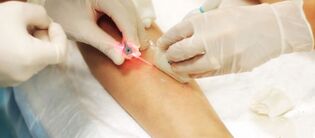
Laser coagulation and sclerotherapy are minimally invasive techniques to exclude veins from the bloodstream. They are used for small diameters of dilated veins in the initial stages of varicose veins (when removing spider veins, nets).
Endovascular laser coagulation of varicose veins
Phlebectomy
Surgical removal of veins is indicated in the third stage of the disease, accompanied by trophic ulcers and complications. In some cases, varicose veins in the legs do not develop according to the model presented in the step-by-step classification. For example, the symptoms of the first stage can be completely absent: an image of undercompensation appears immediately.
Or, as the disease progresses, some signs of varicose veins are not added to the symptoms of the previous stage, but go away. Therefore, at the beginning of the 21st century, in addition to the gradual approach, Russian phlebologists adopted the international classification (CEAP), which, when diagnosing the severity of the disease, takes into account the facts of the individual features of the course of varicose veins and the effects of treatment.
Symptoms
Symptoms of a pathology with the onset of varicose veins do not lead people to think about venous diseases:
- Sensation of heaviness in the legs;
- Tiredness after walking.
They're usually associated with flat feet, unusual high heels, uncomfortable new shoes, and lumbar osteochondrosis.
And only the visual detection of cyanotically dilated veins under the skin gives rise to suspicion of the development of varicose veins.
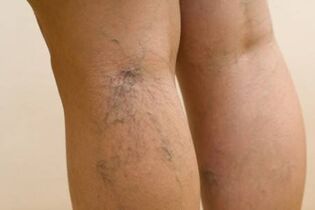
Vascular network as the first sign of varicose veins occurs most often under the knees
Women see a doctor when they notice unpleasant cosmetic defects in the form of reddish-venous "spiders" on the legs, under the knees and on the skin of the thighs.
The “influx” of young women seeking treatment from a phlebologist who specializes in venous disorders is usually associated with the upcoming summer beach season, when they are more concerned with their looks than their health. With the help of pills, they want to restore the beauty of the skin of the legs.
Pregnant women pay more attention to their condition. In addition to cosmetic changes, they note difficulty walking and increased fatigue in the evening.
The initial stage of the disease is indicated by the disappearance of clinical symptoms after lying down.
You can check for yourself by performing this experiment: Measure the volume of the lower leg in the morning and evening after work at the level of the ankle or calf muscles. If the difference is more than 1 cm, there are signs of initial varicose veins.
The following is then displayed:
- pain in the legs;
- swelling of the feet;
- feeling of fullness and heaviness in the legs;
- muscle cramps at night;
- dilated veins become like dense "snake" ligaments with dark areas of skin.
These signs are undoubtedly manifestations of venous insufficiency and must be treated.
The main causes of varicose veins in women
Fatigue and edema can be the first manifestations of a venous blood flow disorder.
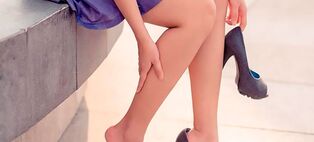
The sex hormone estrogen plays a special role in the development of varicose veins in women. Its effects lead to problems such as weight gain, depression, swelling, drowsiness and dry mucous membranes. This hormone increases the permeability of small vessels. The fluid easily leaves the bloodstream, the blood flows less. Excess fluid accumulates in the surrounding tissue. These factors contribute to the development of stagnation in the vessels of the lower extremities.
Reasons for the increase in estrogen in women:
- An imbalance in estrogen-progesterone production. It occurs as a result of a decrease in the level of progesterone in a woman's body;
- Chronic stress. During stress, the body produces cortisol, which in turn inhibits the synthesis of progesterone.
- pregnancy. During pregnancy, the amount of estrogen in a woman's body increases;
- take contraceptives. Varicose veins are a side effect of taking these medicines;
- Liver disease, as estrogen is removed from the body by the liver. With its poor functioning, this hormone accumulates in the body;
- Age-related changes in the hormone level also lead to an imbalance in the sex hormones with a predominant proportion of estrogen.
Regardless, the reasons for the development of varicose veins should be given as being overweight and a genetic predisposition to this disease. If obesity can and should be combated in the interests of health in general, genetic predisposition cannot be prevented. As a result of these factors, varicose veins have become significantly "younger" and are now common in girls between the ages of 16 and 20.
Full liver function is important to maintain normal hormone levels. In addition to removing excess hormones, it is involved in the synthesis of substances - precursors of progesterone and estrogen. To improve its work, physical activity, good nutrition and minimizing the absorption of toxic substances into the body are necessary.
Treatment of varicose veins with traditional medicine
Treatment of varicose veins in the legs with drugs is the most effective way, which is suitable for almost all patients. A variety of drugs will allow you to choose a more suitable drug for long-term treatment.
Medical methods of treating varicose veins of the legs
Venotonics are among the most potent drugs for treating this disease. Venotonics are drugs that increase the tone of the veins and improve the flow of blood from the veins.
These tablets can prevent the formation of the characteristic varicose veins and nodules.
Apply ointments
The best treatment for varicose veins of the legs is an integrated approach that includes medicines in the form of tablets, as well as the use of gels and ointments for external treatment of problem areas.
Ointment for varicose veins on the legs also helps improve blood circulation and prevent blood clots from forming.
These agents are only recommended after consultation with a doctor, who also determines the duration of treatment and the schedule of use.
Do not treat yourself - this can further damage the patient's already poor condition.
Consequences of varicose veins.
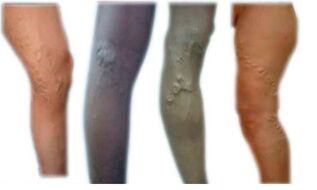
Varicose veins can lead to the development of trophic ulcers on the leg, to thrombosis in the varicose vein system, to thrombophlebitis, to pulmonary embolism (immediate death) in seemingly complete health.
Complicated stages of varicose veins require surgical intervention. Although women are most likely to have varicose veins, men are also affected by the disease, mainly for hereditary reasons.
A man under 40 may appear on the operating table and radical measures are used to cure him of varicose veins - diseased veins are removed.
Removing varicose veins is easy.
The surgeon makes an incision in the groin in which the large saphenous vein, affected by varicose veins, flows into the femoral vein. The vein is exposed, tied, and excised, and a second incision is made in the ankle. With the help of a special metal probe inserted into the lumen of the vessel, the entire enlarged vein is removed.
In the future, with the right technology of the operation, relapses will no longer be observed. The blood supply to the leg is distributed to other vessels, and after 2 weeks everything is completely restored.
Risk factors that predispose to the development of varicose veins.
- Genetics and pathology of connective tissue;
- female;
- taking hormonal drugs: progesterone, estrogen;
- pregnancy;
- Age: more often after 50;
- Obesity and physical inactivity;
- Prolonged stay in an upright position (standing work: hairdressers, salespeople, teachers, etc. );
- obesity.
Symptoms and signs of varicose veins and chronic venous insufficiency.
| Symptoms of varicose veins | External characters |
| Aching pain | Telangiectasia |
| Heavy legs | Reticular veins |
| Fatigue | Varicose veins |
| Swellings | Thrombophlebitis |
| Itchy skin | Hyperpigmentation |
| Leg problems | Trauma nodal bleeding |
| Cramps in the calf muscles | Ulcerations |
Treatment options for varicose veins.
The choice of treatment depends on the diameter and type of varicose veins.
- Varicose veins of the saphenous vein
- drug therapy
- Elastic compression and bandaging of the legs
- Injection sclerotherapy
- Foam sclerotherapy
- Laser therapy
- Miniflebectomy
Dear women, You can wrap varicose veins in long skirts and trousers forever. If the pills and ointments can't bring your legs back to normal, the only safe way to remove the dilated veins remains. In what way and where it is only after consulting a specialized phlebologist. Veins can now be treated surgically without hospitalization, without anesthesia, without incisions and with high precision. You just have to take one step towards your health.
You can find detailed information on varicose veins, symptoms, disease prevention, special exercises, treatment methods and the necessary diet on the website: ovaricoze. ru
How varicose veins manifest themselves in the early stages. Why is he dangerous?
Reticular varicose veins are usually painless. Therefore, the most common ailments that patients turn to are cosmetic defects - visible reticular veins.
In rare cases, the appearance of such a spasmodic network is accompanied by a burning sensation or other changes in skin sensitivity.
In addition to these symptoms, the first stage of varicose veins manifests itself:
- feeling of heaviness in the legs;
- increased leg fatigue;
- cramps in the muscles of the lower extremities, especially at night;
- itching at the point of occurrence of the vascular network;
- swelling of the feet and legs.
To prevent the disease from progressing, treatment must be started on time
It is therefore important to consult a phlebologist, angiologist or vascular surgeon in good time, who will tell you what to do with such skin formations. First of all, a specialist will conduct an examination and prescribe the necessary additional examinations to determine the causes of the appearance of asterisks or meshes and determine the degree of impaired venous blood flow.
To determine the degree of vascular lesions and their inadequacy, do the following:
- complete blood count (indicates whether the patient has anemia or thrombocytopenia);
- biochemical blood test (detects blood clotting disorders or liver and kidney function);
- general urinalysis (detects kidney problems);
- vascular ultrasound - duplex angioscanning (shows the pathology of the vascular wall and blood flow disorders);
- X-ray phlebography with contrast (determines the localization of venous lesions and the degree of impairment of their functions).
If you don't take any action after seeing the first signs of reticular varicose veins, the following is possible:
- inflammatory access and development of thrombophlebitis of the superficial veins of the lower extremities;
- transition of the pathological process from superficial veins of the lower extremities to deep ones;
- Thrombosis of venous vessels. If the thrombosis occurs in the venous vessels of the head, it is dangerous for strokes and sinus thrombosis.
- thromboembolism of the pulmonary arteries is a fatal complication that occurs due to the separation of a blood clot from the vessel wall and blockage of the lumen of the pulmonary arteries.
If you ignore the appearance of incipient reticular varicose veins and do not start treatment in time, the disease will progress. Then the development of complications becomes inevitable.
Prevention
Don't forget about preventive measures. For prevention, you need to devote time to exercise.
Avoid excessive physical activity. Wear comfortable shoes with low heels (up to 4 cm). Remember that hot baths, baths, and saunas all affect leg health.
By following these simple guidelines, you can prevent the development of this disease:
- try to get rid of bad habits - alcohol consumption and smoking negatively affect the condition of your blood vessels;
- Compression Therapy - Wear medical stockings, tights, and knee socks.
- Diet, weight control (overweight people more often suffer from varicose veins), excluding fatty meat and poultry, avoiding spicy and salty foods, including vegetables and fruits in the diet;
- -Massage - Get in the habit of doing a light foot massage after a busy day at work. This will help you relax and improve the body's natural blood flow.
Every disease is always easier to prevent than to cure. Health!














































